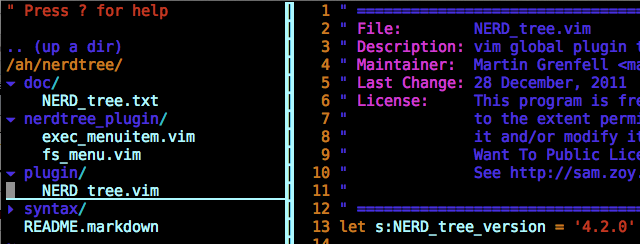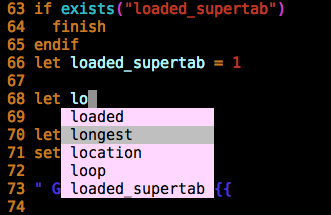In the good ol’ days I used Eclipse, NetBeans, Dreamweaver. Then I switched to TextMate when I started doing Ruby. Now I use Vim for all my Ruby/Javascript development. At this point in my backwards journey through time, I would like to document how you can increase the awesomeness of Vim using a few well-chosen plugins.
First things first: use pathogen.vim. Pathogen allows you to
install each Vim plugin in its own separate directory under .vim/bundle. It
makes your life much less painful.
# Installation procedure from
# https://github.com/tpope/vim-pathogen:
mkdir -p ~/.vim/autoload ~/.vim/bundle
curl -Sso ~/.vim/autoload/pathogen.vim \
https://raw.github.com/tpope/vim-pathogen/master/autoload/pathogen.vim
# Add this to your "~/.vimrc" file:
call pathogen#infect()
NERD tree
This is a filesystem tree that you can display as a sidebar. You can navigate it
with your keyboard and/or mouse. Open it up with :NERDTree.
# Install with pathogen:
cd ~/.vim/bundle
git clone https://github.com/scrooloose/nerdtree

SuperTab
Allows you to use the Tab key for auto-completion.
# Install with pathogen:
cd ~/.vim/bundle
git clone https://github.com/ervandew/supertab

rails.vim
Ruby on Rails power tools. It adds syntax highlighting for methods like
has_and_belongs_to_many, allows you to jump between related files (model,
controller, helper, migration, etc), and more.
# Install with pathogen:
cd ~/.vim/bundle
git clone git://github.com/tpope/vim-rails.git
Command-T
“Go to file” smart plugin. It does pretty awesome things like find
/app/controllers/home_controller.rb just by typing ach. It’s a bit trickier
to install because it has a C Ruby extension for speed.
You must have Vim compiled with Ruby support. To check this, type vim
--version. If +ruby appears in the version information then you have Ruby
support. To compile Vim with Ruby support on OS X with MacPorts, install it with
sudo port install vim +ruby.
# Install with pathogen
cd ~/.vim/bundle
git clone https://github.com/wincent/Command-T
# Build C extension
# WARNING: You must do this with the same Ruby that Vim
# was compiled with. In my case, I have RVM and
# installed Vim+ruby with MacPorts, so I had to
# run "rvm use system" to switch to the
# MacPorts Ruby.
cd ~/.vim/bundle/command-t/ruby/command-t
ruby extconf.rb
make
Once installed, you can bring up the Command-T interface with :CommandT or
<Leader>t. The leader character is your personal modifier key (backslash by
default). I have configured it to be a comma, so I bring up Command-T by typing
,t.
# File: ~/.vimrc
# Use comma as the leader character
let mapleader = ","

fugitive.vim
Git wrapper to call Git commands from Vim. Allows you to manipulate the index, move files with open buffers, and much more. Watch the following screencast for an introduction: Fugitive.vim - a complement to command line git.
# Install with pathogen
cd ~/.vim/bundle
git clone https://github.com/tpope/vim-fugitive
Let the tuning begin.
